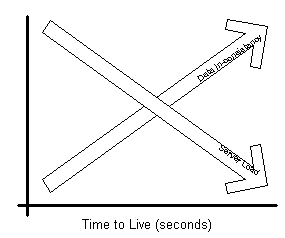
When a name server is processing a recursive query, it may be required to send out several queries to find the definitive answer. The name server caches all of the information that it receives during this process for a time which is specified in the returned data. This amount of time is referred to as the Time to Live (TTL). The name server administrator of the zone that contains the data decides on the TTL for the data. Smaller TTL values will help ensure that data about your domain is more consistent across the network if this data changes often. However, this will also increase the load on your name server.

Once data is cached by a DNS server, it must start decreasing the TTL (that is counting down) from its original value so that it will know when to flush the data from its cache. If a query comes in that can be satisfied by this cached data, the TTL that is returned with the data is the current amount of time left before the data is flushed from the DNS server cache. Client resolvers also have data caches and honor the TTL value so that they know when to expire the data.